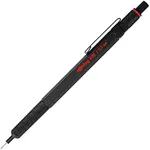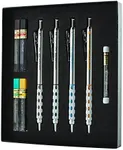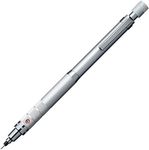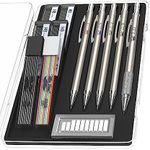Buying Guide for the Best Drafting Pencils
Choosing the right drafting pencil can significantly enhance your drawing or drafting experience. Drafting pencils are designed for precision and control, making them ideal for technical drawings, architectural plans, and detailed artwork. When selecting a drafting pencil, consider the following key specifications to ensure you find the best fit for your needs.Lead SizeLead size refers to the diameter of the pencil lead and is crucial for the level of detail you can achieve. Common lead sizes include 0.3mm, 0.5mm, 0.7mm, and 0.9mm. Smaller sizes like 0.3mm and 0.5mm are ideal for fine, detailed work, while larger sizes like 0.7mm and 0.9mm are better for bolder lines and shading. Choose a lead size based on the type of work you do most often; detailed technical drawings will benefit from smaller leads, while general sketching might be better with larger leads.
Lead HardnessLead hardness affects the darkness and durability of the lines you draw. The hardness scale ranges from 9H (hardest) to 9B (softest), with HB being the middle point. Harder leads (H, 2H, etc.) produce lighter lines and are less prone to smudging, making them suitable for precise technical drawings. Softer leads (B, 2B, etc.) create darker, bolder lines and are better for shading and artistic work. Consider the type of lines you need and choose a lead hardness that matches your drawing style.
GripThe grip of a drafting pencil can greatly affect comfort and control during use. Grips can be made from various materials like rubber, plastic, or metal, and may have different textures. A comfortable grip is essential for long drawing sessions to prevent hand fatigue. If you have a preference for a certain feel or texture, try out different grips to see which one feels best in your hand. For extended use, ergonomic grips with cushioning can provide added comfort.
Weight and BalanceThe weight and balance of a drafting pencil can influence how it feels during use. Some pencils are lightweight and easy to maneuver, while others have a more substantial feel. The balance of the pencil, whether it is more weighted towards the tip or the back, can also affect control and precision. If you prefer a pencil that feels solid and stable, opt for a heavier model. For more agile and quick movements, a lighter pencil might be better. Test different weights and balances to find what suits your drawing style.
MechanismDrafting pencils come with different mechanisms for advancing the lead, such as push-button, twist, or shaker mechanisms. The push-button mechanism is the most common and allows for quick and easy lead advancement. Twist mechanisms offer more control over the amount of lead extended, while shaker mechanisms allow you to advance the lead by shaking the pencil. Consider how you prefer to advance the lead and choose a mechanism that feels intuitive and convenient for you.
EraserMany drafting pencils come with built-in erasers, which can be handy for quick corrections. The quality and size of the eraser can vary, so if you frequently need to erase, look for a pencil with a larger, high-quality eraser. Some pencils also allow you to replace the eraser when it wears out. If you do a lot of erasing, consider the convenience and effectiveness of the built-in eraser when making your choice.






















